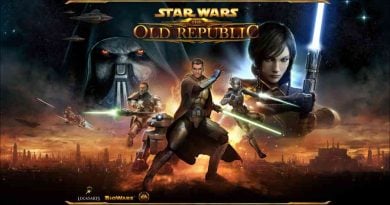‘The Acolyte’ – Leslye Headland Goes Deep into Osha and The Stranger
Fans of The Acolyte got pretty excited by the tense and steamy relationship between Osha and Qimir this week, as the confident yet vulnerable Manny Jacinto attempted to seduce Osha towards the dark side.
The Acolyte creator and showrunner Leslye Headland spoke to Collider all about this in a truly mammoth interview which provided some interesting clarity on the subject (she encourages the “Oshamir” shipping name). She also talked about The Acolyte‘s review bombing, confirmed that Qimir’s home is definitely not on Ahch-To, and was pretty tight-lipped about the use of Kylo Ren’s theme in relation to The Stranger. You can read the full interview to see everything she said, but we’ll be highlighting everything regarding Osha and Qimir below.
While Headland did admit that Osha and Qimir’s dynamic was inspired by Crouching Tiger, Hidden Dragon, she mostly tried to write what she knew.
“I wanted to just click into the kind of stuff that I wrote when I was in high school. I love these characters. Nobody wants to ship these characters more than I do. I love them so much. I love The Stranger. There’s always a character that’s an avatar for me that I really, really love. In Russian Doll, it was Charlie [Barnett’s] character, Alan.
“The Stranger is obviously a badass, but I just mean much more than his character. I’m not going around doing fantastic lightsaber battles and murdering people and being an all-around badass, but I would say that what he talks about in this episode and what he talked about in [Episode] 5 is something I really dug down. Then Osha’s inner conflict fits with his ideology, and yet they’re on opposite ends of the spectrum just like she and her sister started at the beginning of the show. I wanted to stay true to my characters. I tried my best to just stick to the tropes and the stuff that I loved and tried not to think about, especially [with] the classics. I think it would have been a little too quotes-around-it if that were the case.
“That being said, the relationship between Lo and Jen in Crouching Tiger, Hidden Dragon was an influence in the writer’s room. We referenced that relationship over and over again. The intentional parallel is that they are equals and their relationship is earned through mutual vulnerability, not intimidation or manipulation.”

Another influence was the Rey and Ben Solo dynamic from The Last Jedi, as Ben begs Rey to leave the Jedi and join him, which perhaps could be a reason why Kylo Ren’s theme has been appearing so much in The Acolyte.
“There are two examples I’ll use. Honestly, with Kylo and Rey, there was really just one moment that was sort of the seed that planted the tree of this relationship. It was just Adam [Driver’s] delivery when he says, “Join me,” and then they cut to her and then he says, “Please,” in this incredibly vulnerable, almost heartbreaking way, where you understand how lonely and lost this guy is because he murdered his dad. You see it in his performance before the Leia moment in that movie, but it was specifically him standing in front of her and showing himself in such a vulnerable place.
“I wouldn’t say I took too much from the dynamics after that, because the second thing that was really important to me was that Osha never tried to turn him. I don’t want to say I didn’t like that dynamic, I just think it’s a dynamic I wasn’t interested in. Because a lot of ETL is like, “There’s good in you, blah, blah, blah.” I think when she sees him straight-up murder people, she’s not like, “There’s good in you!” [Laughs]”
Leslye went even deeper in detailing their relationship, claiming that Qimir’s not entirely manipulating her. He’s just being honest, hoping to awaken her own anger with Sol and the Jedi Order by getting her to realize some home truths.
“So, in my opinion, Osha is extremely in denial about her own anger at the Jedi and at her father, i.e. Sol. She’s in extreme denial about that because she feels like she’s not allowed to be angry, and she’s in an enormous amount of pain over her sister and their history, and she also feels like she’s not allowed to feel that. So, someone coming in and saying, “Actually, feeling all those things is not only okay but actually could restore your spiritual foundation,” is almost too much. I don’t think that’s manipulation. I think he’s telling her the truth.
“When he says “semantics,” I think he means it. He’s just like, “Why wouldn’t you use what is obviously the part of you that needs to be explored the most? Why wouldn’t you lean into that? Why would you continue to suppress it for, really, no reason? The Jedi threw you away, so what are we still doing? What is this thing that you are thinking? You don’t owe them anything. You owe yourself to start living your life and recognize your own strength in The Force.””

She added that she didn’t want to Qimir to come off as too alpha male or intimidating, as she felt that he had to seem vulnerable in order to let Osha soften around him. She also touched on that Osha is wearing gray because she is struggling with both the light and dark sides of the Force at this point in the story.
“…the dynamics had to be what they are after what he did in [Episode] 5. He cannot seem like an alpha male-y, intimidating — we know he’s capable of that from 5 — but that cannot be his dynamic with her. It wouldn’t make sense! We have to see this other side of him, and we have to see specifically the way he is with her. He never let Mae see his face, and he let her see him naked. You know what I mean? The character design was very, very intentional.
“But also this is, again, this is the story of the bad guys. So unlike Rey and Kylo, where Rey is always in these lighter colors, and he’s in black, then the Sith would be in white and the character, really, that’s struggling with both sides would be wearing gray. It just seems like it had to be that way.”

The Acolyte has suggested several times that Osha leaving the Jedi Order was a mutual break up of sorts. She is adamant it was her decision, but there’s also a sense that the Jedi were equally happy for her to leave. Headland explained that after talking with Pablo Hidalgo, there would have been a ritual of sorts that saw Jedi voluntarily give up their lightsaber upon leaving, as part of a ritual they undergo when leaving the order.
“Pablo Hidalgo and I talked about that a lot because, obviously, in Ahsoka we see that, but in live-action, we haven’t totally seen the process of what that would look like. But one thing Pablo and I talked about was turning in your saber — that there would be a ceremony around relinquishing your saber and that it would happen of your own free will.
“It wouldn’t be taken from you, you would offer it up, and it would be a part of the ceremony of your leaving. So, I just loved the concept of him tapping into, again, this part of herself that is quote-unquote missing and saying, “How does it feel to hold one in your hand again?” Because that’s a tactile way of saying, “Clearly, you miss it.””
Leslye Headland also spoke about Force dyads, and that while the Jedi might not be aware of that concept at this point, the Sith might be, as they will be looking for anything to give them the edge against the Jedi. It seems Qimir might be interested in Mae and Osha because of this unique relationship between the two of them.
“In my opinion, the Jedi wouldn’t necessarily have that vocabulary right away. What I thought was interesting is that the Sith may be searching for something that would help them along with a larger quest and that Osha and Mae would possibly be a part of that.So, the power of two can mean a couple of different things. I would say primarily it means the relationship between two Sith. However, I think there’s a secondary meaning that will be revealed later in the story.
“Yes, I think the concept of a Force Dyad is very important to the story, even if it isn’t necessarily name-checked, because I think that the Sith are much more aware of what a Dyad is, and I think the Jedi haven’t figured that out yet in terms of how powerful that particular relationship between two Force-sensitive beings could be. There are many things in the High Republic that the Jedi would consider mythology or lack the language to describe, whereas the Sith know that they exist. I think the Sith are also tuned in to some aspects of The Force and ways to manipulate The Force that the Jedi are just not tuned into yet.”

Some fans have felt a little uncomfortable with the characterization of the Jedi as a people and organization that aren’t necessarily all good with some skeletons in their closet, and Leslye Headland claims she understands that opinion, though she believes that setting The Acolyte 100 years before the films means that these Jedi are just very different to the ones that George Lucas specifically created.
“I hope it’s making people look at it from a different point of view. I can understand that fans — especially people who don’t know the High Republic — may feel like I’m criticizing the Jedi as they exist in George Lucas’ oeuvre, meaning the prequels and Episodes 5 through 6, but that’s not the case. We’re so much further back from that. We’re in that era that Obi-Wan is talking about in A New Hope. We’re in that period where the proliferation of power is so huge and far-reaching. Actually, in the next episode, you’re gonna see how far-flung particular missions with Jedi are and the lack of oversight.
“Yeah, so comparing these Jedi to the Jedi in the prequels is a little difficult because it’s 100-ish years. It’s a century. So you see Vernestra’s like, “We cannot let this happen.” She gets more and more concerned about that at the end of the season, and rightfully so because she, as a very powerful Jedi Master, can sort of see what’s on the horizon, whereas, when we meet the Jedi in the prequels, they’re completely enmeshed at that point.
“… one of the interesting ways to unpack the Jedi is, when they are at their height as they are here, what are the things they’re doing differently? A Jedi doesn’t pull their weapon unless prepared to kill — that’s just a High Republic concept. They don’t have battle droids, they don’t have other people with lightsabers. There isn’t any reason to pull it. Comparing that to anybody in the prequels, it’s not the same. They’re just not the same Jedi. So, in my opinion, and in my experience, and what I was interested in digging into is, it seems like it’s a time where you can break down the Jedi as a concept, whereas I wouldn’t want to touch what has been established of them a century later.”
We’ll get to see Osha and Qimir’s relationship continue to develop in the final two episodes of The Acolyte.
Josh is a huge Star Wars fan, who has spent far too much time wondering if any Star Wars character could defeat Thanos with all the Infinity Stones.








